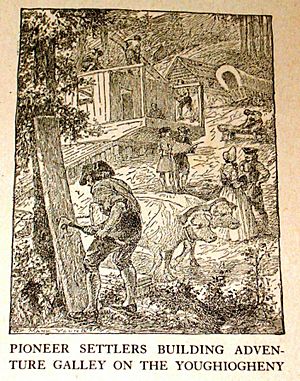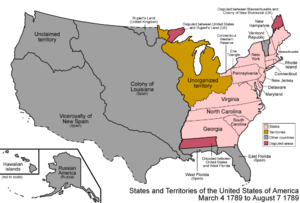American pioneer facts for kids

American pioneers were brave settlers who moved westward across North America. These pioneers were both European American and African American people. They traveled from the original Thirteen Colonies and later the United States. Their goal was to settle and develop new lands. These lands were often already home to Native American communities.
The idea of a "pioneer" is older than the famous move to the Western United States. Many places now seen as "East" were once settled by pioneers from even further east. For example, Daniel Boone was a famous pioneer. He settled in Kentucky when it was still wild and undeveloped.
One big step in settling the West was the Homestead Act. This law helped organize how settlers could claim land. It made the settlement process more official.
Contents
Who Were the American Pioneers?
Many famous people in American stories and books show what a pioneer was like. James Fenimore Cooper wrote The Deerslayer in 1841. This book was part of his Leatherstocking Tales series. It showed pioneer life in New York.
Later, Laura Ingalls Wilder wrote the Little House on the Prairie books. These were published from 1932 to 1943. They told stories about pioneer families in the 1870s and 1880s. Real-life heroes like Daniel Boone (1734–1820) and Davy Crockett (1786–1836) became symbols of pioneer history.
How Did Westward Settlement Happen?
Early Moves West
The first moves westward happened as the Thirteen Colonies grew. Each colony wanted to open up new lands to its west. Some colonies had royal charters that did not set a western limit. This meant they could claim land indefinitely westward.
After the United States was formed, the government started to help with settlement. This made the process more organized. The Land Ordinance of 1785 was the first official step. It decided how new territories would be governed.
The Northwest Ordinance of 1787 was a very important law. It said that individual states could not claim new lands on their own. Instead, the national U.S. government would handle exploration. In the Land Act of 1804, the government began to make laws. These laws explained how pioneers could claim and receive individual plots of land.
Government Support for Settlers
The government also encouraged westward movement in other ways. For example, The Prairie Traveler was published in 1859. This was three years before the Homestead Act. Randolph B. Marcy, a U.S. Army Captain, wrote it. The War Department asked him to create a guide for people moving west.
The guide gave important information. It listed mileage and good stopping points for travelers. It also gave advice on what to bring on the journey. It even taught settlers how to interact with Native Americans and handle dangerous situations, like meeting bears.
There were other ways land was claimed too. Some areas had "land runs". In a land run, people would race to claim land. The Land Rush of 1889 in Oklahoma is a famous example. Parts of Oklahoma territory were opened, and anyone could claim land first.
Life on the Frontier
As more people moved west, common ways of life emerged. Most pioneers traveled in wagon trains. These were groups of wagons carrying settlers and their families. They traveled together for safety. They also combined their efforts to make the journey easier.
Pioneers in the East often had to clear thick forests. In the Midwest, their main job was to make the Great Plains good for farming.
Some pioneers moved west to claim land and start farms for their families. Others were trappers or business people. They went west for trade and stayed if their businesses did well.
See also
 In Spanish: Pionero de Norteamérica para niños
In Spanish: Pionero de Norteamérica para niños


